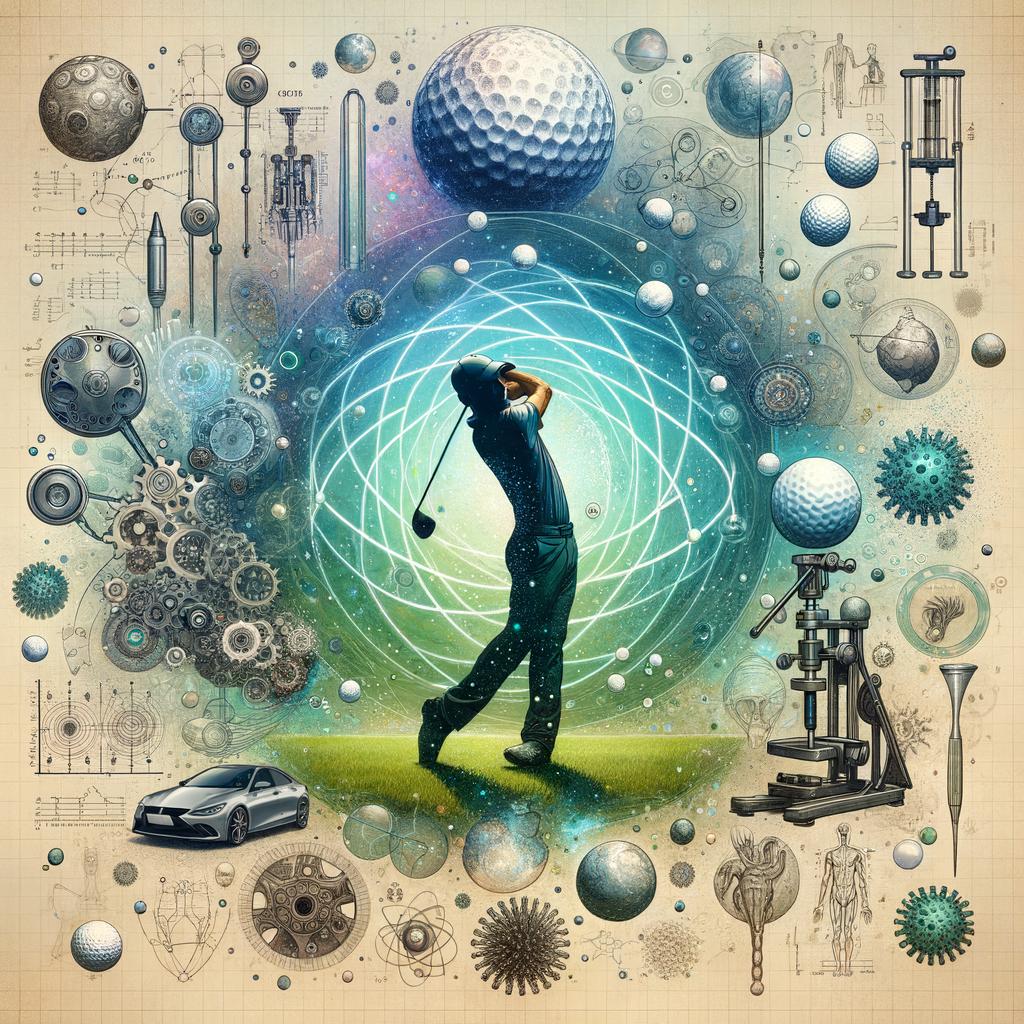Exploring the Ancient Journey of Golf: An In-Depth Perspective
Golf, a sport renowned for its deep-rooted traditions and refined etiquette, embodies a unique blend of athleticism, culture, and history. Its beginnings can be traced back to the rugged terrains of 15th-century Scotland, marking the inception of a game that would evolve into a beloved global pastime. This article aims to navigate through golf’s complex historical landscape,detailing its transformation from primitive games played with basic sticks and stones to the refined modern sport governed by standardized regulations and international organizations. Key milestones in equipment progress, the establishment of the 18-hole format, and societal influences on course design will be examined. Through archival research and expert insights, this study seeks to shed light on golf’s lasting appeal while highlighting how meaningful innovations and cultural shifts have shaped its character over time.
Uncovering Golf’s Origins: A Look at Early games and Cultural Influences
The roots of golf can be linked to various ancient games played across different civilizations that contributed elements recognizable in today’s sport.Historical evidence indicates that similar stick-and-ball games were played in ancient Roman and Persian cultures where players aimed at targets with balls struck by sticks. These early forms highlighted an essential aspect of golf: merging physical skill with strategic thought. Gradually,these diverse games converged into a more defined version in Scotland during the 15th century when modern golf began taking shape.
In Scotland specifically, social dynamics significantly influenced golf’s status. The endorsement from King James IV in 1502 was crucial for elevating its profile from a lower-class pastime to an aristocratic pursuit. This royal patronage not only legitimized golf but also ingrained it within Scottish culture as an emblem of social prestige. As interest spread beyond Scotland’s borders, regions adopted their own rules leading to distinct variations that enriched golfing traditions.
The evolution of golf courses mirrors this journey as they adapted alongside cultural practices over time. Early Scottish courses utilized natural landscapes effectively; their designs often capitalized on existing terrain challenges enhancing gameplay experience. Today’s course designs reflect both tradition and innovation as contemporary architects create layouts honoring historical essence while incorporating advanced technologies.
The Evolution of Golf Rules: Tradition Meets Standardization
The origins of golfing regulations are closely tied to its rich heritage primarily emerging from Scotland during the 15th century when informal rules varied widely across regions. It wasn’t until late in the 19th century that standardization became necessary due to growing popularity—especially following prominent club establishments—leading towards cohesive rule formation.
A pivotal moment occurred with the founding of the Royal and Ancient Golf Club in St andrews in 1754 which was instrumental in establishing uniform rules shaping how golfers engaged with their game across burgeoning landscapes.
Over time significant revisions reflected both gameplay evolution alongside societal changes surrounding it; major codifications took place during years such as 1899, 1934, 1952 &1984 aiming at simplifying play while maintaining integrity through notable adjustments like eliminating unneeded strokes for infractions or introducing equipment regulations ensuring fairness among competitors.Main aspects include:
- Crisp Definitions: Establishing clear terms like “teeing ground” or “penalty areas.”
- Equipment Standards: Ensuring clubs & balls meet performance criteria promoting fair competition.
- User Responsibilities: Clarifying player conduct expectations emphasizing etiquette importance on-course interactions.
This tradition is further reinforced by social norms governing player interactions which are deeply embedded within golfing culture—rituals such as pre-round handshakes or respect towards fellow players illustrate customs coexisting harmoniously alongside established regulations ensuring respectfulness remains paramount throughout gameplay experiences.
A brief overview summarizing influential rule changes is presented below:
| Date | Pivotal Rule Changes |
|---|---|
| 1754 | The foundation laid down by Royal & Ancient Club regarding modern rules. |
| 1899 | The introduction standardized definitions enhancing clarity around terms used within play contexts. |
| 1934 | A major simplification effort along with penalty stroke introductions reflecting evolving needs within competitive environments; |
Course Design Impact on golf Practices: Historical Changes & Innovations
The trajectory taken by course design has historically been influenced heavily through prevailing cultural values coupled together technological advancements along environmental considerations impacting layout choices made throughout history itself! Initially laid out upon open fields/coastal terrains where natural topography dictated playability emphasis remained focused solely upon creating basic experiences devoid any sophisticated features whatsoever! Tho once popularity surged particularly during late nineteenth/twentieth centuries architects began innovating beyond simplistic layouts integrating elements challenging players’ skills strategically improving pacing whilst enhancing allure associated precision mental acuity required!
This shift coincided notably alongside technological innovations including new materials developed specifically catering greens/course maintenance needs revolutionizing upkeep allowing lush playable landscapes nonetheless climatic conditions faced! Moreover advancements turf technology fostered creation resilient grass types improving overall playability under varying weather patterns encountered regularly!<Strong Architects started integrating features strategically placed bunkers/water hazards creating visual appeal introducing tactical elements requiring golfers adapt gameplay strategies accordingly reflecting broader trends sports promoting skill development!
Sustainability practices gained traction late twentieth/early twenty-first centuries prompting further evolution considering environmental impacts designers prioritized eco-friendly approaches utilizing native plant species fostering wildlife habitats aligning awareness conservation efforts preserving natural beauty courses whilst together introducing innovative design elements enriching golfer experiences demanding strategic planning/adaptive gameplay ultimately transforming engagement levels between participants/game itself!
Technological Progress In Golf Shaping Modern Game
The interplay between technology/golf catalyzed enhancements equipment/training methodologies fundamentally altering ways individuals engage/play this beloved pastime recently decades past one notable leap being utilization computer-aided design (CAD) developing clubs/balls enabling manufacturers experiment materials/design optimizing performance outcomes achieved via advanced crafting techniques utilizing carbon fiber showcasing durability improvements weight reductions facilitating higher swing speeds greater distances increased accuracy achieved compared conventional counterparts reflecting commitment blending science/sport seamlessly together!
Additionally integration smart tech into equipment represents another milestone witnessed recently clubs equipped sensors tracking metrics clubhead speed face angle tempo providing customized insights performances facilitating tailored training regimens precise fittings understanding individual swing characteristics refining techniques ultimately enhancing overall gaming experience encouraging deeper recognition nuances inherent sport fostering strategic approaches practice competitions alike!
| Technological Innovation | Impact On Game |
|---|---|
| CAD In Club Design | Enhances performance Optimized materials Geometries |
| Smart Sensors Equipment | Provides Accurate Swing Data Personalized Training Regimens |
| High-Tech Balls Used Today ! ! ! ! ! ! !! !! !! !! !!!!!! !!!!!! !!!!!! !!!! !!!! !!!! !!!! !!!!!!!!!! !!!!!!!!!! !!!!!!!!!! !!!!!!!!!! !!!!!!!!!! !!!!!!!!!! !!!!!!!!!! !!!!!! !!!!!! !!!!!! !!!!!!!!!!!!!!!!!!!!!!!!!!!!!!!!!
As we continue embracing these advances ways assess skills approach game inevitably evolve representing profound shifts competitive landscape athletes now possess access unparalleled data/tools implications extend beyond individual performances influencing coaching techniques/course designs reshaping entire golfing experience unprecedented manners! Evolution Of Communities Clubs Societies Global Influencethe transformation seen among communities involved reflects broader societal changes especially noted late nineteenth early twentieth centuries initially regarded pastimes gentry gaining traction affluent classes worldwide emergence exclusive societies catering lifestyle centered leisure/social status examples include country clubs providing networking spaces gatherings sporting events intertwining elite identities structures! As popularity extended continents formal organizations emerged guiding evolutions establishment governing bodies USGA/Royal Ancient Club introduced standardized rules fostering global approaches published ‘Rules Of Golf’ promoted club establishments worldwide leading proliferation societies embracing amateur competitive tournaments transitioning local pastimes globally recognized structured competitions professional circuits! Today legacies resonate adapting contemporary values inclusivity focusing diversity welcoming members backgrounds communities technological advancements rise digital platforms redefining operations enthusiasts connect globally share experiences camaraderie online membership options virtual tournaments exemplifying evolving meet new generation ensuring enduring allure remains strong amidst rapidly changing social landscapes! concluding RemarksGolf’s evolution narrates fascinating intertwining athletic developments societal transformations technological innovations originating fifteen-century characterized improvised rugged landscapes today sophisticated globally recognized sports celebrating rich traditions marked resilience adaptability formalized governing bodies shifting toward standardized formats/equipment reflect dynamic nature responding needs growing audiences exploring intricate histories appreciating enduring appeals gaining insight broader cultural/social transformations mirrored centuries serving foundations enthusiasts scholars alike engaging multifaceted forms! From Scottish Greens to Global fairways: The Engaging Journey of Golf through TimeMeta TitleThe history of Golf: From Scotland to Global Fairways Meta DescriptionExplore the fascinating journey of golf, its origins in Scotland, evolution, adn global spread.Discover key milestones, famous tournaments, and the impact of golf on culture and society. The Origins of GolfGolf is widely recognized as a product of Scottish innovation. Historical evidence suggests that the game’s roots extend back to the 15th century in Scotland, where it began on natural terrain with rudimentary clubs and balls made from leather or wood. Evidence from History
Golf’s Development through the AgesThroughout the centuries, golf evolved significantly, transitioning from its primitive forms to a more structured sport. The following sections outline key stages in its development. 16th to 17th Century: StandardizationThe game’s community solidified its rules in the late 16th century, leading to the establishment of standard practices that informed play.
Emergence of Professional PlayThe 19th century marked a crucial turning point as golf transitioned to formal play.
Golf’s Global SpreadThe late 19th and early 20th centuries saw golf expand beyond British shores, captivating audiences and establishing clubs worldwide. Key Influences on Global expansion
Growth in America
Golf’s Cultural ImpactGolf transcends mere sport; it influences culture, lifestyle, and economies. Key aspects of its cultural importance include: Social and Economic Contributions
Global Events and Championshipsmajor tournaments like The Masters, Open Championship, and Ryder Cup are not just competitions; they are global spectacles.
The Technological Evolution of GolfEquipment AdvancementsTechnological innovations have greatly enhanced the sport, particularly in equipment design.
Course DesignModern golf course design emphasizes environmental sustainability while maximizing challenge and enjoyment. Design Principles
Popular Golf Courses Around the Worldtable of Iconic Golf Courses| Course Name | Location | Year Established | Notable Tournaments | |—————————–|———————–|——————|———————————–| | The Old course | St. Andrews, Scotland | 1552 | Open Championship | | Pebble Beach Golf Links | California, USA | 1919 | U.S. Open | | Augusta National Golf Club | Georgia, USA | 1933 | The Masters | | Royal Melbourne Golf Club | Australia | 1891 | World Cup of Golf | Unique Characteristics
Benefits of Playing GolfPhysical and Mental HealthPlaying golf has numerous benefits,highlighting its appeal beyond mere recreation.
Social InteractionGolf encourages socialization through play, tournaments, and community events, emphasizing teamwork and sportsmanship. Tips for Aspiring GolfersGetting StartedHere are some practical tips for those new to the sport:
Enjoying the game
By examining the historical context, cultural impact, and evolution of golf, it’s clear that the sport has woven itself into the fabric of societies globally. Whether as a competitive sport, a leisure activity, or a means of social interaction, golf remains a cherished pastime with a rich legacy. You might be interested in …
Johnny Miller: Mastering the Art of Golf Through Expert InstructionJohnny Miller, renowned for his exceptional golf prowess, has also distinguished himself as an esteemed instructional guru. His methodology, honed through years of championship-level experience, offers an unparalleled pathway to golf mastery. Miller emphasizes precision, incorporating cutting-edge swing analysis techniques to identify and correct mechanical inefficiencies. Through his renowned television commentary and instructional programs, he expertly conveys complex principles, making golf accessible to both aspiring players and seasoned veterans seeking to elevate their game. 
Schauffele Sets PGA Record with 62 at Travelers ChampionshipXander Schauffele has etched his name into the annals of golf history, shooting a record-setting 10-under 62 in the opening round of the Travelers Championship. This remarkable feat matches the lowest opening round ever recorded in a major, set by Schauffele himself at the 2018 Masters Tournament. With this triumph, Schauffele leads the field by a commanding three strokes. His round was highlighted by an eagle, nine birdies, and a solitary bogey on the par-70 TPC River Highlands course. 
**”Mastering Golf: Unlock Your Potential with Academic Insights!”**Unleash the powerful connection between academic guidance and golf excellence. Transform your game with insightful strategies that blend learning and skill for unmatched performance on the course |



